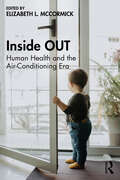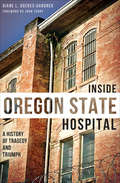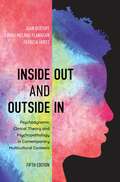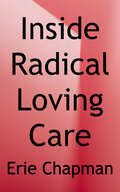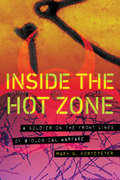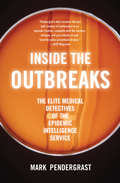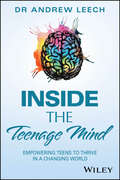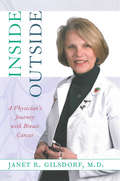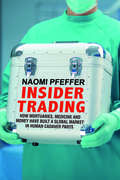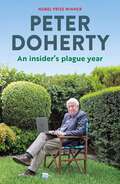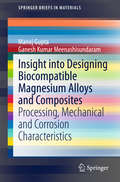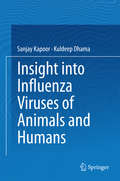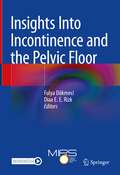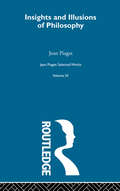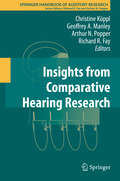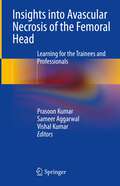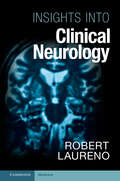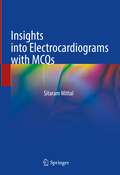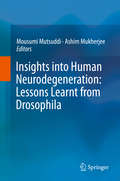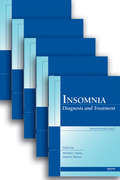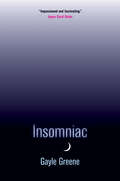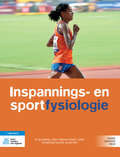- Table View
- List View
Inside OUT: Human Health and the Air-Conditioning Era
by Elizabeth L. McCormickInside OUT: Human Health and the Air-Conditioning Era focuses on the enclosed environment of fully conditioned buildings, revealing a unique ecosystem with broad implications for human life and a rapidly expanding global footprint. Emphasizing the interconnections between buildings and human health, equity, and environmental sustainability, it presents an interdisciplinary, holistic analysis of the social, behavioral, and technological issues of indoor space.Over the 20th century, advances in mechanical conditioning technologies led to the dispersion and international dominance of the sealed building envelope, which casually and progressively disconnected buildings and their occupants from local climatic, biological, and cultural environments. At the same time, humans were increasingly pushed indoors by less tangible, socially constructed forces that associated climate control with cleanliness, health, social status, and modernization.In this volume, a multi-disciplinary group of experts on the indoor microbiome from the fields of biology, anthropology, and architecture come together to thoughtfully reflect on the history, properties, and meaning of indoor air quality in buildings, and to discuss the future of human habitation – with a dominant focus on human health in a post-pandemic world. Taking a human-first approach to health and sustainability, the authors weave together a compelling analysis of social and technological drivers of conditioned space with arguments for future interventions in the built environment.Amid growing awareness of air quality and climate concerns, Inside OUT provides a timely discussion of the relationship between building design and human health, of relevance to professional and academic readers from across the spectrum of the building industry, as well as fields including public health and environmental studies.
Inside Oregon State Hospital: A History of Tragedy and Triumph (Landmarks Ser.)
by Diane L. Goeres-GardnerA look inside the historic mental hospital that served as the location for One Flew Over the Cuckoo&’s Nest—includes photos. Seen through the eyes of those who lived there, this book examines the world of a mental hospital established in Salem, Oregon, in 1883—where, in desperate attempts to cure their patients, physicians injected them with deadly medications, cut holes in their heads, and sterilized them. Years of insufficient funding caused the hospital to decay into a crumbling, understaffed facility, which was later used as the setting for the 1975 film One Flew Over the Cuckoo&’s Nest. Today, after a $360 million makeover, Oregon State Hospital is a modern treatment hospital for the state&’s civil and forensic mentally ill. In this compelling account of the institution&’s tragedies and triumphs, author Diane Goeres-Gardner offers an unparalleled look at the very human story of Oregon&’s historic asylum.
Inside Out and Outside In: Psychodynamic Clinical Theory and Psychopathology in Contemporary Multicultural Contexts
by Joan Berzoff Laura Melano Flanagan Patricia HertzThis book has established itself as a foundational book for mental health practitioners in a variety of disciplines who work with clients in complex social environments. It is unique in its focus on the forces that shape people from within and also from their social worlds, with sensitivity to race, gender, sexuality, and class. The fifth edition features new material and revisions throughout while maintaining the respectful and accessible style for which the book is known. It has been fully updated to reflect the changing political and social landscape, regarding women's issues, immigration issues, and racism, to name just a few. Two new chapters have been added on Biopsychosocial Assessment and Neurobiology. In addition, the authors reinforce intersectionality and diversity through case studies in every chapter. The fifth edition is an up-to-date and essential resource for mental health professionals and students practicing in today’s increasingly complex environment.
Inside Out: The Social Meaning of Mental Retardation
by Steven J. Taylor Robert Bogdan Seymour B. Sarason'We have to assume that the mind is working no matter what it looks like on the outside. We can't just judge by appearance...If you take away the label they are human beings.' Ed MurphyWhat does it mean to be 'mentally retarded'? Professors Bogdan and Taylor have interviewed two experts, 'Ed Murphy' and 'Pattie Burt,' for answers. Ed and Pattie, former inmates of institutions for the retarded, tell us in their own words.Their autobiographies are not always pleasant reading. They describe the physical, mental, and emotional abuses heaped upon them throughout their youth and young adulthood; being spurned, neglected, and ultimately abandoned by family and friends; being labelled and stigmatized by social service professionals armed with tests and preconceptions; being incarcerated and depersonalized by the state.Ed and Pattie survived these experiences--evidence, perhaps, of the indefatigable will of the human spirit to assert its essential humanity--but the wounds they have suffered, and the scars they bear, have not been overcome. They are now contributing, independent, members of society, but the stigma of 'mental retardation' remains.Their stories are both true and representative--powerful indictments of our knowledge of, our thinking about, and our ministrations to, the mentally handicapped. The interviewers argue that Ed and Pattie challenge the very concept of 'mental retardation.' Retardation, they assert, is an 'imaginary disease'; our attempts to 'cure' it are a hoax.Read Ed's and Pattie's accounts and judge for yourself.
Inside Psychosis: A clinical and therapeutic exploration of working on male and female acute psychiatric wards
by Helen L HolmesThis book offers an introductory overview of treatment of psychosis in inpatient acute ward settings, looking at both male and female wards. Taking a broadly psychoanalytic perspective, the book explores the organizational dynamics on male and female acute wards, exploring both patient and staff dynamics. Containing detailed case studies from across male and female psychiatric wards in London, the author sets out how psychoanalytic concepts, such as transference, questions of trauma, and issues of gender can shape both the presentation of psychosis and our understanding and treatment of it. The book then explores the part played by religion in psychosis and equips readers with ideas for future practice and training on psychosis. With clear guidance on how to understand and work with psychosis in an inpatient setting, and how many unconscious factors can affect patients and staff, this is key reading for psychiatrists, psychoanalysts and therapists, clinical psychologists, and other mental health professionals working in inpatient acute care and community settings.
Inside Radical Loving Care
by Erie ChapmanThis book distills the essence of the author's three previous books into a single slender volume. It equips caregivers with stories of powerful examples and all the tools they need to live Love, not fear, every day and night. Execute the ideas in this book and your life and your work culture will change for the better. As a result, every patient's care will improve.
Inside the Hot Zone: A Soldier on the Front Lines of Biological Warfare
by Mark G. KortepeterInside the Hot Zone is an insider&’s account of one of the most dangerous workplaces on earth: the United States Army Medical Research Institute of Infectious Diseases (USAMRIID) in Fort Detrick, Maryland. Retired U.S. Army Col. Mark G. Kortepeter, a leading biodefense expert, recounts his journey from the lecture hall to the role of department chief, to the battlefield, to the Biosafety Level-4 maximum containment lab, and finally, to the corner office. During Kortepeter&’s seven and a half years in leadership at USAMRIID, the United States experienced some of the most serious threats in modern germ warfare, including the specter of biological weapons during the Iraq War, the anthrax letters sent after 9/11, and a little-known crisis involving a presumed botulism attack on the president of the United States. Inside the Hot Zone is a shocking, frightening eye-opener as Kortepeter describes in gripping detail how he and his USAMRIID colleagues navigated threats related to anthrax, botulism, smallpox, Lassa, and Ebola. Kortepeter crafts a rich and riveting narrative as he wrestles with life-and-death decisions managing biological weapon exposures. The stories are real, but they could just as easily serve as plotlines in popular fiction or Hollywood thrillers. He gives the reader a seat at the table as each crisis unfolds, with an unvarnished and personal perspective on the dangers, the drama, the fear, the frustrations, the irony, and the uncertainty he encountered as a physician in the role of &“Biodefender.&”
Inside the O'Briens: A Novel
by Lisa GenovaFrom the New York Times bestselling author of Still Alice Lisa Genova comes a powerful and transcendent new novel about a family struggling with the impact of Huntington's disease.Joe O'Brien is a forty-four-year-old police officer from the Irish Catholic neighborhood of Charlestown, Massachusetts. A devoted husband, proud father of four children in their twenties, and respected officer, Joe begins experiencing bouts of disorganized thinking, uncharacteristic temper outbursts, and strange, involuntary movements. He initially attributes these episodes to the stress of his job, but as these symptoms worsen, he agrees to see a neurologist and is handed a diagnosis that will change his and his family's lives forever: Huntington's Disease. Huntington's is a lethal neurodegenerative disease with no treatment and no cure. Each of Joe's four children has a 50 percent chance of inheriting their father's disease, and a simple blood test can reveal their genetic fate. While watching her potential future in her father's escalating symptoms, twenty-one-year-old daughter Katie struggles with the questions this test imposes on her young adult life. Does she want to know? What if she's gene positive? Can she live with the constant anxiety of not knowing? As Joe's symptoms worsen and he's eventually stripped of his badge and more, Joe struggles to maintain hope and a sense of purpose, while Katie and her siblings must find the courage to either live a life "at risk" or learn their fate. Praised for writing that "explores the resilience of the human spirit" (The San Francisco Chronicle), Lisa Genova has once again delivered a novel as powerful and unforgettable as the human insights at its core.
Inside the Outbreaks: The Elite Medical Detectives of the Epidemic Intelligence Service
by Mark PendergrastThe &“fascinating&” story of the CDC&’s intrepid investigators, who travel the world to protect us from deadly pathogens (Chicago Tribune). Since its founding in 1951, the Epidemic Intelligence Service has waged war on every imaginable ailment. When an epidemic hits, the EIS will be there to crack the case, however mysterious or deadly, saving countless lives in the process. Over the years they have successfully battled polio, cholera, and smallpox, to name a few, and in recent years have turned to the epidemics killing us now—smoking, obesity, and gun violence among them. The successful EIS model has spread internationally: former EIS officers on the staff of the Centers for Disease Control have helped to establish nearly thirty similar programs around the world. EIS veterans have gone on to become leaders in the world of public health in organizations such as the World Health Organization. Inside the Outbreaks takes readers on a riveting journey through the history of this remarkable organization, following Epidemic Intelligence Service officers on their globetrotting quest to eliminate the most lethal and widespread threats to the world&’s health.
Inside the Teenage Mind: Empowering Teens to Thrive in a Changing World
by Andrew LeechA must-have guide for parents and professionals navigating the complexities of today's youth. Teenagers are navigating one of the most complex and transformative stages of life—full of rapid change, emotional highs and lows, and evolving identities. Thriving Through Teenage Years: An Expert's Guide to Adolescent Health blends cutting-edge research with real-world case studies and expert insights to provide a comprehensive roadmap for supporting teens. This must-have guide tackles the most pressing challenges facing today’s teens: Tackles the big issues facing teens—offering practical strategies to support them through challenges like anxiety, body image, identity struggles, substance use, and social pressures. Takes a holistic approach—exploring the interactions between physical and mental health in teens. Guides you through supporting a teen engaging in risky behaviors—including self-harm and suicidal thoughts, with practical advice on how to approach difficult conversations and a safety plan template to help create a structured, supportive response. Explores the influence of digital media and artificial intelligence—examining the important links between technology, teenage behavior, brain development, and mental health. Provides practical tools and strategies—featuring easy-to-use checklists, questions to ask your doctor or psychologist, signs that indicate when to seek help, a comprehensive resource list and communication tips tailored to different stages of adolescence. Features real-life case studies—with powerful insights from teens and their families, sharing their struggles, successes, and the strategies that helped them get through. Takes a neuroaffirming approach—offering guidance on understanding teenage challenges through a neurodiverse lens, supporting the unique needs of all adolescents. Written for—parents, educators, and professionals in psychology, education, social work, and healthcare professionals who support adolescents. Thriving Through Teenage Years takes a compassionate and practical approach to understanding teenage behavior and fostering resilience. Drawing on over a decade of experience as a General Practitioner working with teens, Dr. Andrew Leech shares expert advice on maintaining open communication, supporting mental health, navigating screen use, and empowering young people with the tools they need to thrive. More than just a guide, this book is about helping teens find their purpose, embrace their identity, and recognize the value they bring to the world.
Inside/Outside: A Physician's Journey with Breast Cancer
by Janet R. GilsdorfIn 2000, pediatrician and epidemiologist Janet Gilsdorf (U. of Michigan Medical School) learned that she had breast cancer. In this memoir, she uses a stream-of-consciousness style to recount her journey from diagnosis through various treatments and (ultimately) recovery. She also offers a vivid account of the struggle she faced in reconciling her dual identity as physician and patient. Annotation ©2007 Book News, Inc. , Portland, OR (booknews. com)
Insider Trading: How Mortuaries, Medicine and Money Have Built a Global Market in Human Cadaver Parts
by Naomi PfefferThe cadaver industry in Britain and the United States, its processes and profits Except for organ transplantation little is known about the variety of stuff extracted from corpses and repurposed for medicine. A single body might be disassembled to provide hundreds of products for the millions of medical treatments performed each year. Cadaver skin can be used in wound dressings, corneas used to restore sight. Parts may even be used for aesthetic enhancement, such as liquefied skin injections to smooth wrinkles. This book is a history of the nameless corpses from which cadaver stuff is extracted and the entities involved in removing, processing, and distributing it. Pfeffer goes behind the mortuary door to reveal the technical, imaginative, and sometimes underhanded practices that have facilitated the global industry of transforming human fragments into branded convenience products. The dead have no need of cash, but money changes hands at every link of the supply chain. This book refocuses attention away from individual altruism and onto professional and corporate ethics.
Insider's Plague Year
by Peter DohertyIn An Insider's Plague Year, Nobel laureate and prominent COVID-19 authority Professor Peter Doherty recounts his response to the pandemic as it developed from January 2020-February 2021. As citizens and governments around the world suddenly became acutely dependent on the capacity of scientists to understand and recommend appropriate public health policy responses to the disease, Doherty and his team were at the forefront. In his always conversational style, Doherty systematically provides a deep understanding of the virus and of the numerous areas of knowledge that have been brought together in the fight against it. Rendering complex medical and scientific issues accessible and providing a fascinating glimpse into how health experts have worked with governments to control and manage the challenge, Doherty also turns his mind to what we can hope for in the months and years ahead, considering even larger questions about the pivotal role of science in our lives.
Insight into Designing Biocompatible Magnesium Alloys and Composites
by Manoj Gupta Ganesh Kumar MeenashisundaramThis book critically summarizes the effects of various suitable alloying elements and particulate reinforcements on mechanical and degradation properties of pure Mg and Mg alloys targeting biomedical applications. The suitability of alloying elements and particulate reinforcements are discussed based on their levels of toxic effects on human body. First attempt is made to study and discuss on the various available synthesizing techniques for fabrication of both impermeable and porous Mg materials. Further, more emphasis on development of new magnesium matrix nanocomposites (MMNC) is made owing to the similarities between natural bone and MMNCs as bio-"nanocomposite". The information on synthesis, toxicity of alloying elements and reinforcements and their effects on mechanical and degradation properties of pure Mg will enable the researchers to effectively design Mg alloys and composites targeting biomedical applications.
Insight into Influenza Viruses of Animals and Humans
by Sanjay Kapoor Kuldeep DhamaThis book provides salient information on all aspects of influenza/flu viruses affecting animals and humans. It specifically reviews the properties and replication of influenza viruses; their evolution and emergence; epidemiology; role of migratory birds in disease transmission; clinical signs in humans, animals and poultry; pathogenesis and pathogenicity; public health importance and potential threats; diagnosis; prevention and control measures; and pandemic preparedness. Influenza/flu viruses evolve continuously and jump species causing epidemics as well as pandemics in both human and animals. During the past 150 years, various strains of influenza virus like the Spanish flu, Asian flu, Hong Kong flu, bird flu and swine flu were responsible for high mortality in humans as well as birds. High mutation rates, antigenic shifts, drifts, reassortment phenomena, and the development of antiviral drug resistance all contribute to ineffective chemotherapy and vaccines against influenza viruses. Due to their devastating nature, high zoonotic implications and high mortality in humans and poultry, they have a severe impact on the socioeconomic status of countries. Disease awareness, rapid and accurate diagnosis, surveillance, strict biosecurity, timely adoption of appropriate preventive and control measures and pandemic preparedness are crucial to help reduce virus transmission, thus reducing clinical cases, deaths and pandemic threats.
Insights Into Incontinence and the Pelvic Floor
by Fulya Dökmeci Diaa E. E. RizkThis book collects valuable studies in the field of pelvic medicine, reflecting the latest technologies and innovations for maintaining pelvic floor health and managing incontinence and pelvic floor disorders in both men and women. It provides an authoritative and multidisciplinary perspective from Mediterranean experts in the field, mainly focusing on obstetrics and gynecology, urogynecology, urology, female urology, colorectal surgery, and physiotherapy. Collecting innovative ideas and studies based on recent developments, with detailed background information, the book will shed new light on the subject and serve as a valuable reference guide for graduate students, researchers, and practicing professionals interested in continence and pelvic floor management.
Insights and Illusions of Philosophy: Selected Works vol 9
by Jean PiagetFirst published in 1997. Routledge is an imprint of Taylor & Francis, an informa company.
Insights from Comparative Hearing Research
by Arthur N. Popper Richard R. Fay Christine Köppl Geoffrey A. ManleyThe hearing organs of non-mammals, which show quite large and systematic differences to each other and to those of mammals, provide an invaluable basis for comparisons of structure and function. By taking advantage of the vast diversity of possible study organisms provided by the "library" that is biological diversity, it is possible to learn how complex functions are realized in the inner ear through the evolution of specific structural, cellular and molecular configurations. Insights from Comparative Hearing Research brings together some of the most exciting comparative research on hearing and shows how this work has profoundly impacted our understanding of hearing in all vertebrates.
Insights into Avascular Necrosis of the Femoral Head: Learning for the Trainees and Professionals
by Vishal Kumar Prasoon Kumar Sameer AggarwalThe book is an overview of a vital Orthopedics topic, avascular necrosis (AVN) of the hip. It encompasses all the aspects of this disease in terms of etiology, epidemiology, pathogenesis, diagnosis, staging, and treatment. It covers the recent advances and evidence-based approaches to diagnosis and management, with easy to understand tables and pictures. This book is a comprehensive guide with chapters on presentation and examination of such a case with knowledge about frequently asked questions. Included multiple-choice questions on the topic will further aid in revision and recapitulation. This book is a helpful tool for Senior Residents, faculty members in teaching institutions as well as practicing Orthopedic surgeons all across the globe. Knowing how to examine, diagnose and manage a case of AVN hip is a must for any Orthopedic surgeon, and they have to be aware of all recent advances without fail. This book is on a topic which is a “must keep” clinical case in all Orthopedic exit exams; encapsulated with every nuance of the disease, it will be beneficial across all the career stages of Orthopedic surgeons.
Insights into Clinical Neurology
by Robert LaurenoThis illuminating book clarifies controversial topics in challenging and often confusing areas of neurology for all who are interested in clinical neuroscience. It provides an organized approach to neurological conditions such as amnesic syndrome, aphasia, agnosia and apraxia, it includes previously unpublished data on grasp reflex and Wernicke disease is presented. Written by an internationally renowned author, the book draws on his extensive personal experience to orient neurological clinicians to a variety of conditions by putting less accessible literature into context with recent advances and information from interviews undertaken throughout his career. This book will appeal to general and specialist neurologists, nurse practitioners, physician's assistants and those training to specialise in neurology.
Insights into Electrocardiograms with MCQs
by Sitaram MittalThe present is bundled with several unique features. It provides up-to-date information on electrocardiograms for almost all electrocardiographic abnormalities covers all aspects of surface electrocardiography in detail. Summaries follow all book chapters for quick revision and MCQs for self-assessment. This book will be helpful to clinicians, fellows in medicine preparing for different careers in cardiology, and ECG technicians and their teachers.The purpose of writing this book - While teaching undergraduates, postgraduates in general medicine, and students of diploma course in cardiac instrument technology, I realized that the students did not have the knowledge of basic concepts of electrocardiography and did not know the clinical significance of various abnormalities. Students, therefore, felt that the subject was difficult to understand and of no clinical significance. Students, therefore, did not feel interested. There was a need for a book that could simplify the subject to the ground level for a beginner who does not know even the basics of electrocardiography. Most of the books in this field are targeted towards cardiologists with an understanding that the reader already has enough knowledge of the basic concepts of electrocardiography. MCQs are the cornerstone for learning, teaching, and evaluation. None of the books in the market gives the idea of MCQs in electrocardiography. What problem does this book solve for the readers? - This book explains various normal and abnormal findings with the help of diagrams and illustrative electrocardiograms. Clinical implications of multiple abnormalities are discussed. This makes the subject easy to understand and to interest for a beginner. MCQs will help the readers in self-assessment. MCQs will also help teachers and examiners in evaluating the students.
Insights into Human Neurodegeneration: Lessons Learnt from Drosophila
by Mousumi Mutsuddi Ashim MukherjeeThis book is aimed at generating an updated reservoir of scientific endeavors undertaken to unravel the complicated yet intriguing topic of neurodegeneration. Scientists from Europe, USA and India who are experts in the field of neurodegenerative diseases have contributed to this book. This book will help readers gain insight into the recent knowledge obtained from Drosophila model, in understanding the molecular mechanisms underlying neurodegenerative disorders and also unravel novel scopes for therapeutic interventions. Different methodologies available to create humanized fly models that faithfully reflects the pathogenicities associated with particular disorders have been described here. It also includes information on the exciting area of neural stem cells. A brief discussion on neurofibrillary tangles, precedes the elaborate description of lessons learnt from Drosophila about Alzheimer's, Parkinson’s, Spinomuscular Atrophy, Huntington’s diseases, RNA expansion disorders and Hereditary Spastic Paraplegia. We have concluded the book with the use of Drosophila for identifying pharmacological therapies for neurodegenerative disorders. The wide range of topics covered here will not only be relevant for beginners who are new to the concept of the extensive utility of Drosophila as a model to study human disorders; but will also be an important contribution to the scientific community, with an insight into the paradigm shift in our understanding of neurodegenerative disorders. Completed with informative tables and communicative illustrations this book will keep the readers glued and intrigued. We have comprehensively anthologized the lessons learnt on neurodegeneration from Drosophila and have thus provided an insight into the multidimensional aspects of pathogenicities of majority of the neurodegenerative disorders.
Insomnia: Diagnosis and Treatment
by Daniel J. Buysse Michael J. SateiaThe first source on insomnia treatment since the advancement of newer drug options and cognitive behavioral therapies, Insomnia: Diagnosis and Treatment presents a comprehensive reference on the complications, evaluation, and treatment of insomnia. Ideal for sleep medicine specialists, psychiatrists, and neurologists, this text uses a multi-discipl
Insomniac
by Gayle GreeneIn this revelatory book, Gayle Greene offers a uniquely comprehensive account of insomnia, a devastating and little-understood condition. She shares comments from neurologists, sleep researchers, doctors, psychotherapists, and insomniacs of all sorts. This work provides an up-to-date account of what is known about the little known realm of insomnia.
Inspannings- en sportfysiologie
by Jack H. Wilmore David L. Costill W. Larry KenneyInspanningsfysiologie is dé basis voor het begeleiden van bewegen, bijvoorbeeld voor training, bewegingsonderwijs en oefentherapie. Dit boek is het wereldwijde standaardwerk voor de inspannings- en sportfysiologie. De auteurs van de Amerikaanse uitgave, Larry Kenney, Jack Wilmore en David Costill, zijn absolute topwetenschappers op dit vakgebied. Deze vierde, geheel geactualiseerde, Nederlandse editie van Inspannings- en sportfysiologie biedt toegankelijke, goed leesbare, wetenschappelijk onderbouwde, up-to-date kennis. Dit bijzonder complete boek besteedt veel aandacht aan de basisinspanningsfysiologie: Hoe werkt het menselijke lichaam tijdens inspanning? Daarnaast kijkt het uitgebreid naar de invloed van de omgeving op ons lichaam (hoogte, warmte, kou) en naar de invloed van leeftijd en sekse bij inspanning en sport. Verder wordt ingegaan op trainen voor prestaties, en de invloed daarop van voeding en lichaamssamenstelling. Ook de aanpak en effecten van bewegen gericht op gezondheid komen uitgebreid aan de orde. Deze editie is uitgebreid met nieuwe informatie over uiteenlopende onderwerpen als moleculaire adaptaties, obesitas, diabetes type II, bioinformatica, eiwitsynthese en spierkramp. De uitgave is rijk geïllustreerd en bevat tal van praktische en aansprekende voorbeelden en zelfstudievragen aan het eind van elk hoofdstuk. Online zijn Engelstalige videofragmenten en animaties beschikbaar Gedegen kennis van inspannings- en sportfysiologie is onmisbaar voor (aankomende) bewegingswetenschappers, docenten lichamelijke opvoeding, fysiotherapeuten, coaches, trainers en andere professionals op het gebied van bewegen. Met de kennis van Inspannings- en sportfysiologie, zowel een handboek als een compleet naslagwerk, is het mogelijk uit te groeien tot een professionele begeleider. De vertaler, drs. Gerard van der Poel, is bewegingswetenschapper (VU, 1989) en werkt sinds 1993 als zelfstandig inspanningsfysioloog. Gerard is een zeer ervaren docent, trainer, adviseur en auteur. Hij verzorgt onder meer nascholingen voor fysiotherapeuten en trainers. Gerard van der Poel is (mede)auteur van zes boeken en vele artikelen in vaktijdschriften.
